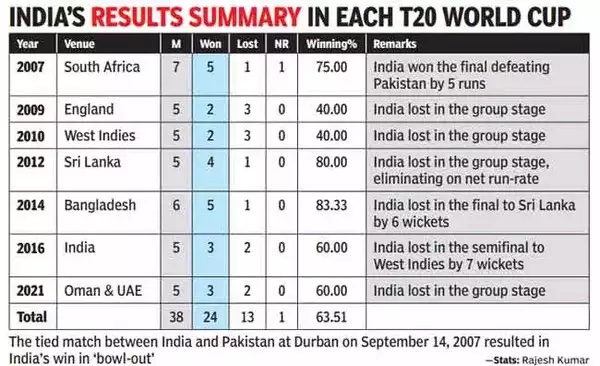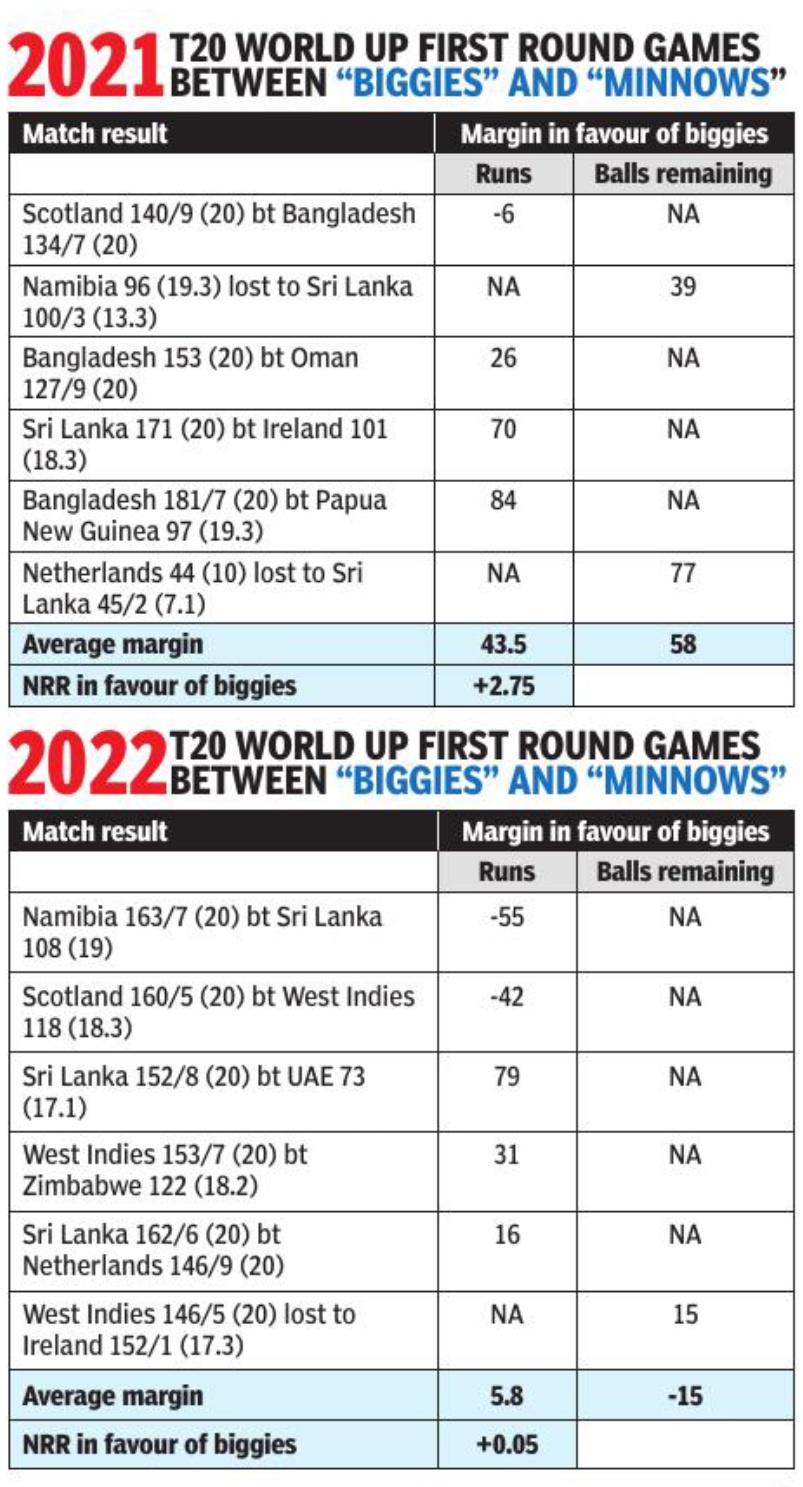T20 World Cup (Men’s)
This is a collection of articles archived for the excellence of their content. |
Contents |
History
Trivia
Oct 18, 2022: The Times of India
The eighth edition of the ICC Men's T20 World Cup began in Australia last Sunday with the qualifying-stage matches, from where four teams will join the top eight in the 'Super 12' phase beginning October 22.
While the tournament gathers steam leading up to the high-octane India vs Pakistan clash on October 23, here are some very interesting facts and trivia about the T20 World Cup, which is the biggest stage in the shortest format of the sport.
((All statistics in this article are updated till the last edition of the T20 World Cup in 2021))
Australia can create history: Hosts Australia have the rare chance of becoming the first team to successfully defend their T20 World Cup crown.
Two-time champions: The West Indies are the only team to have won the T20 World Cup two times - in 2012 and 2016.
Players to have played in all seven T20 World Cups so far: Rohit Sharma, Chris Gayle, Dwayne Bravo, Shakib Al Hasan, Mahmudullah and Mushfiqur Rahim are the six players who have featured in all seven T20 World Cups held till date.
Most appearances in the final: Sri Lanka is the team to have reached the final of a T20 World Cup the most times. They have played three finals so far (2009, 2012, 2014), winning the title once, when they defeated India in the summit clash of the 2014 edition.
Fastest 50: The mention of the fastest half-century in a T20 World Cup straight away brings back the memory of six sixes in a Stuart Broad over hit by Yuvraj Singh, who still holds the record for the fastest fifty that he scored in the same innings against England in the inaugural edition in 2007.
Fastest 100: This record stands in the name of West Indies opener Chris Gayle, who notched up a hundred off just 48 balls against England in a Super 10 Group 1 match in the 2016 edition.
Chris Gayle: Only batsman to have scored two T20 World Cup centuries (117 off 57 balls vs SA in 2007 & 100* off 48 balls vs Eng in 2016) Biggest win by runs: Sri Lanka scored a mammoth 260/6 in 2007 against Kenya and then went on to dismiss the opponents for just 88 runs to register a huge 172-run victory.
Most runs overall: Former Sri Lanka captain Mahela Jayawardene -- 1016 runs in 31 matches
Most runs in a single edition: Former India captain Virat Kohli -- 319 runs in six matches in the 2014 edition
Most wickets overall: Former Bangladesh captain Shakib Al Hasan -- 41 wickets in 31 matches
Most wickets in a single edition: Sri Lanka's Wanindu Hasaranga -- 16 wickets in 8 matches in the 2021 edition
Most dismissals by a wicketkeeper overall: Former India captain MS Dhoni - 32 dismissals (21 catches and 11 stumpings)
Highest Team Total: 260/6 by Sri Lanka vs Kenya in 2007
Lowest Team Total: 39 by Netherlands vs Sri Lanka in 2014.
India’s results
2007-21
Partha Bhaduri, Oct 21, 2022: The Times of India

From: TNN, Partha Bhaduri, Oct 21, 2022: The Times of India
See graphic:
India’s results in the T20 World Cup, 2007-21
MELBOURNE: These are strange times in the fast mutating world of T20s. The pressure to constantly win in what is essentially a fickle, abridged version of something intended to play out over longer hours has resulted in some quirky thinking. On the back of the hundreds of games played in franchise cricket across the world and the hours of data they provide, the format has evolved to become a highly strategic, high-on-unorthodox-skills game.
Multiple backroom inputs, power-hitting obsessions, relentless slow bowling and wide-yorker remedies, rigid and predictable match-ups have all contributed to nearly erasing the element of surprise. Yet captains and coaches continue to believe in these trends because it all somehow works, or because they believe it works.
A batter, for example, may believe he will get to face a Harshal Patel slower ball but is still unable to find a way to manoeuvre past it. Conversely, an unfancied team may find itself better placed to upset the apple cart against bigger, better, more resourceful outfits, like we have seen already in this T20 World Cup, though it has barely just begun.
So where does that leave India, who kickstarted the public obsession with this format by winning the first-ever World T20 in South Africa back in 2007? It seems like just yesterday that a longhaired, fresh-faced and unfancied MS Dhoni successfully led a team of either those looking to prove themselves for the first time, or those looking to prove themselves all over again.
Those were the days of cricketers either cautiously dipping their toes in uncharted waters or, like some of India’s biggest cricketers did at that time, thumbing their noses at the format. The monetization came later.
Among the big names in that team, Virender Sehwag was looking to make a comeback in more ‘important’ formats while Gautam Gambhir was desperately seeking more game time. Irfan Pathan proved his worth again but was already being considered a has-been. Yuvraj and Harbhajan played key roles. Rohit Sharma, captain now, was still a relative unknown looking to make it big and proved his class at crucial moments.
Rahul Dravid, coach now, captain in other formats then until he stood down, will remember the impact of the tournament. Funnily enough, a bizarre ‘bowlout’ decided a tied Indo-Pak game late into one Durban night, and what should have been perceived as a completely non-serious affair instead led to fervent, jingoistic crowd chants which drowned out Dhoni’s voice in the post-match interaction.
An electric final, again against Pakistan, Yuvraj’s six sixes... has there ever been a more memorable T20 event? It was still the days of anchor-hitter opening combos and basically an ODI approach to the 20-over game, but nonetheless there was some element of the intangible, some whiff of what we call ‘magic’, that sparked the public imagination. It was Indian cricket remixed in a refreshing manner.
Fifteen years later, Rohit is leading the team in Australia looking for a second T20 world title, making him the best placed to put a finger on the intangibles and take a leaf out of what went right in 2007.
“It has been a while since we won the World Cup,” Rohit told bcci.tv. “The motive and the whole thought process is to win the World Cup, but we know that we need to do a lot of things right to get there, so one step at a time for us.”
Rohit will know that one big part of that ‘magic’ came from Dhoni himself. His captaincy and bowling changes were, simply put, effective. India had just played a solitary T20I before the event, not the glut of matches teams play now, and T20 had not yet been dissected ad infinitum, allowing Dhoni some creative freedom.
Some of Dhoni’s moves turned the tide India’s way at crucial moments, like opting for non-regular bowlers like Uthappa and Sehwag in the ‘bowlout’, unlike Pakistan, or using RP Singh so cannily against South Africa, or using Joginder Singh to defend 13 runs in the last over in the final. Dhoni dared to think out of the box and the new, untested format allowed him to do so.
Minnows, so-called
2021, 22
TNN, Oct 22, 2022: The Times of India

From: TNN, Oct 22, 2022: The Times of India
If there is one thing the group 1 stage of this T20 World Cup has driven home, it is that there are no longer any 'minnows' at the event. The stage started with former champions Sri Lanka being thrashed by Namibia and ended with Ireland dumping the West Indies, the only team to have won the Cup twice, out of the competition.
But it isn't just anecdotal evidence that suggests a narrowing of the gap between the so-called 'minnows' (a group in which most people include Test playing nations Zimbabwe and Ireland) and the 'biggies'. A comparative look at the combined results of matches involving one of the minnows and a biggy in the last edition in 2021 and the current one bears out this gut feel.
There were six games involving one of the big teams (Bangladesh and Sri Lanka in 2021 and West Indies and Sri Lanka this time) against one of the others in the group 1 stage in both 2021 and 2022. If we treat the two big teams as one entity and the rest as the other entity, the net run rate between the two was +2. 75 for the biggies.
That's collapsed to just +0. 05 in 2022, which is as close to even as you can get.
The average margin of victory across the six matches has also come down drastically. In 2021, Sri Lanka and Bangladesh won three of the six games batting first and Bangladesh lost out narrowly to Scotland while chasing. The average margin in favour of the biggies (counting the six-run deficit as a negative margin) was 43.5 runs. Two games were won by the big two while chasing with 58 balls or nearly ten overs to spare on average.
Switch to 2022 and five of the six games were won by the team batting first, two of them by the minnows (Scotland vs West Indies and Namibia vs Sri Lanka) and the rest by the big two.
The average margin in favour of the biggy across these five games (again counting a deficit as a negative margin) was just 5.8 runs.
India, Pakistan, Bangladesh and South Africa might be celebrating the fact that they will have neither West Indies nor Sri Lanka in their group, but they would do well to jettison any notions that it makes things easier for them.